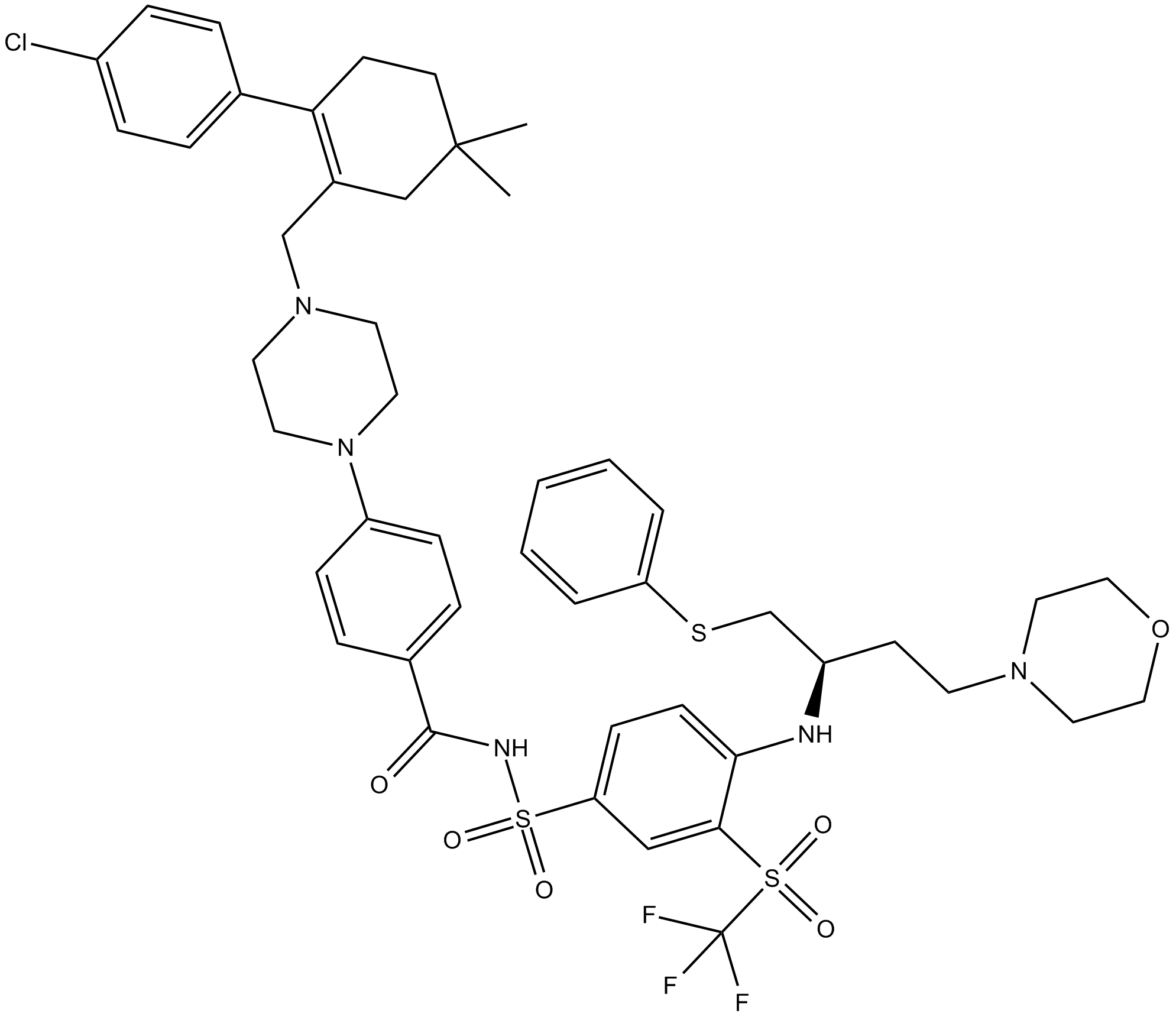ABT-263 (Navitoclax) (Synonyms: Navitoclax,ABT-263,ABT263,ABT 263) |
| Catalog No.GC12405 |
ABT-263 (Navitoclax) is a inhibitor of Bcl-xL, Bcl-2 and Bcl-w, with Ki ≤0.5 nM, ≤1 nM and ≤1 nM respectively[1].
Products are for research use only. Not for human use. We do not sell to patients.

Cas No.: 923564-51-6
Sample solution is provided at 25 µL, 10mM.
ABT-263 (Navitoclax) is a inhibitor of Bcl-xL, Bcl-2 and Bcl-w, with Ki ≤0.5 nM, ≤1 nM and ≤1 nM respectively[1].
ABT-263 (Navitoclax) is senolytic in some, but not all types of senescent cells: Navitoclax reduced viability of senescent human umbilical vein epithelial cells (HUVECs), IMR90 human lung fibroblasts, and murine embryonic fibroblasts (MEFs)[2]. Navitoclax (1μM ; 60 hours) accelerates apoptosis mainly by inhibiting Bcl-xL[8].
ABT-263 (Navitoclax)exhibited modest (IC50=3-8 μM) single agent potency in 8 ovarian cancer cell lines. Navitoclax(0.4μM;30h) enhanced the activation of caspase 3/7 induced by carboplatin and/or paclitaxel in Igrov-1 cells [3]. Multiple lymphoid subpopulations isolated from the thymi or BM of vavP-Bcl-2 transgenic mice were markedly more sensitive to ABT-263 (Navitoclax)[4].
ABT-263 (Navitoclax) (100 mg/kg/d;p.o;once daily for 21 days) treated a mouse model inoculated with H345 cells, and significant antitumor efficacy was observed [6]. Navitoclax with venetoclax and chemotherapy was well tolerated and had promising efficacy in patients with relapsed/refractory acute lymphoblastic leukemia or lymphoblastic lymphoma[5]. In 44 xenograft models representing 9 different histologies, ABT-263 (Navitoclax) (100 mg/kg/d;i.g; 21 days)demonstrated limited single agent in vivo activity against the PPTP's(pediatric preclinical testing program)solid tumor panels but showed significant activity against xenografts in the ALL panel [7].
References:
[1]. Tse C, Shoemaker AR, et,al. ABT-263: a potent and orally bioavailable Bcl-2 family inhibitor. Cancer Res. 2008 May 1;68(9):3421-8. doi: 10.1158/0008-5472.CAN-07-5836. PMID: 18451170.
[2]. Zhu Y, Tchkonia T, et,al.Identification of a novel senolytic agent, navitoclax, targeting the Bcl-2 family of anti-apoptotic factors. Aging Cell. 2016 Jun;15(3):428-35. doi: 10.1111/acel.12445. Epub 2016 Mar 18. PMID: 26711051; PMCID: PMC4854923.
[3]. Stamelos VA, Robinson E, et,al. Navitoclax augments the activity of carboplatin and paclitaxel combinations in ovarian cancer cells. Gynecol Oncol. 2013 Feb;128(2):377-82. doi: 10.1016/j.ygyno.2012.11.019. Epub 2012 Nov 17. PMID: 23168176.
[4]. Mérino D, Khaw SL, et,al. Bcl-2, Bcl-x(L), and Bcl-w are not equivalent targets of ABT-737 and navitoclax (ABT-263) in lymphoid and leukemic cells. Blood. 2012 Jun 14;119(24):5807-16. doi: 10.1182/blood-2011-12-400929. Epub 2012 Apr 26. PMID: 22538851; PMCID: PMC3382939.
[5]. Pullarkat VA, Lacayo NJ, et,al.Venetoclax and Navitoclax in Combination with Chemotherapy in Patients with Relapsed or Refractory Acute Lymphoblastic Leukemia and Lymphoblastic Lymphoma. Cancer Discov. 2021 Jun;11(6):1440-1453. doi: 10.1158/2159-8290.CD-20-1465. Epub 2021 Feb 16. PMID: 33593877; PMCID: PMC9533326.
[6]. Shoemaker AR, Mitten MJ, et,al. Activity of the Bcl-2 family inhibitor ABT-263 in a panel of small cell lung cancer xenograft models. Clin Cancer Res. 2008 Jun 1;14(11):3268-77. doi: 10.1158/1078-0432.CCR-07-4622. PMID: 18519752.
[7]. Lock R, Carol H, et,al. Initial testing (stage 1) of the BH3 mimetic ABT-263 by the pediatric preclinical testing program. Pediatr Blood Cancer. 2008 Jun;50(6):1181-9. doi: 10.1002/pbc.21433. PMID: 18085673.
[8].Shi J, Zhou Y, Huang HC, Mitchison TJ. Navitoclax (ABT-263) accelerates apoptosis during drug-induced mitotic arrest by antagonizing Bcl-xL. Cancer Res. 2011 Jul 1;71(13):4518-26. doi: 10.1158/0008-5472.CAN-10-4336. Epub 2011 May 5. PMID: 21546570; PMCID: PMC3129452.
Average Rating: 5 (Based on Reviews and 30 reference(s) in Google Scholar.)
GLPBIO products are for RESEARCH USE ONLY. Please make sure your review or question is research based.
Required fields are marked with *




